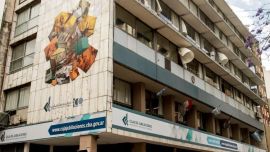Poverty in Argentina rose to affect more than half of the population in the first six months of Javier Milei's Presidency, according to official data released Thursday.
In total, 52.9 percent of the population qualified as poor in the first half of this year – a jump of 11.2 percentage points from the last measurement in the second half of 2023 and affecting almost 25 million people nationwide.
Nearly one in five are living in extreme poverty – 18.2 percent of the citizenry or 8.5 million Argentines.
Extreme poverty is understood as the poor whose incomes do not even suffice to buy the minimum quantity of food to permit subsistence. At the end of last year it had climbed to 11.9 percent after being 9.3 percent in midyear.
The data stems from the EPH (Encuesta Permanente de Hogares) household survey from the INDEC national statistics bureau. The information divulged by the agency measures the first six months of the Javier Milei administration, marking a new record since 2004 when Argentina was still weathering the crisis triggered by the 2001 meltdown.
A poverty index of 52.9 percent tops the 41.7 percent at the end of last year and the 40.1 percent of mid-2023.
"The percentage of households below the poverty line reached 42.5 percent where 52.9 percent of people reside. Within this group, 13.6 percent of the households containing 18.1 percent of people stand out," read INDEC’s report.
The bureau’s implies that out of a population of 46 million, 24.3 million are poor, among whom 8.3 million do not have the minimum money to buy the food to guarantee their subsistence.
The inflation in the first half of this year was 79.8 percent and even though wages improved 84.3 percent, not all employees received the same.
Only registered workers in the private sector obtained increases topping inflation at 93.6 percent while the pay of state employees rose 73.3 percent and the informally employed 69.8 percent, reported INDEC.
Furthermore, during the first half of the year economic activity dipped 3.2 percent while unemployment rose from 5.7 percent at the end of last year to 7.6 percent in midyear, according to the bureau’s data.
The latest survey from the UCA Catholic University’s Observatorio de la Deuda Social (ODSA-UCA) poverty watchdog placed 52 percent of the population below the poverty line, thus marking a record since 2004, while destitution reached 17.9 percent.
Their report shows the figure peaking at 54.9 percent in the first quarter before dipping to 49.4 percent between April and June as a result of decelerating inflation and real wage pickup.
Austerity bites
Since taking office in December, Milei's government has applied a drastic austerity programme with the aim of eliminating the budget deficit and taming chronic inflation. It has slashed subsidies for transport, fuel and energy, even as thousands of public servants lost their jobs.
Monthly inflation in Argentina came in at four percent in July, the lowest figure in two-and-a-half years, before rising again to 4.2 percent in August. Yet the annual figure of 236.7 percent in August remains one of the highest in the world.
In December, when Milei took office, monthly inflation leapt by 25.5 percent after he devalued the peso by more than 50 percent. The move, in addition to severe budget cuts, strangled purchasing power.
In January, the government reported its first monthly budget surplus in nearly 12 years. But critics say Milei's few successes have come at the cost of the poor and working classes. GDP fell 1.7 percent in the second quarter and unemployment rose to 7.6 percent, with women hardest hit.
Milei’s officials continue to preach "historic austerity" due to the “dire inheritance” received.
Nevertheless, the Executive Branch is confident that the macroeconomic order implemented will make it possible to improve the poverty index, which will be reflected in the third quarter.
The brutal austerity has registered direct consequences for economic activity, employment and wages. Even if some macroeconomic data are positive such as the fiscal surplus or lower inflation ,the recession hits vulnerable sectors where it hurts most..
“It is fundamental to stress as many times as necessary that structural poverty in Argentina did not arise from the actions of this government,” maintained the CNCPS (Consejo Nacional de Coordinación de Políticas Públicas) policy council, adding: “The data show that the socio-economic policies of the past failed structurally, perpetuating the situation we now have.”
"In a country where poverty is measured by income, we have all become poorer," Presidential Spokesperson Manuel Adorni said Thursday ahead of the INDEC release, which he predicted would reflect a "harsh reality."
"The best way to fight against poverty is to fight against inflation," he added.
“It was the worst inheritance in history,” said Adorni.
“It is a consequence of populism subjecting the country to so many years of misfortune and devastation,” he said, adding: “The government inherited a disastrous situation, probably the worst inheritance received by a government in democracy in the history of Argentina.”
"They left a whole bunch of time-bombs ticking which affected economic activity, real wages and inflation," said Adorni during his daily press conference.
‘Increasingly broken’
Economist Marina Dal Poggetto said the government’s approach "excludes a lot of people" and "creates an increasingly broken society."
One such person is Viviana Quevedo, 57, who lost her job as a maid in December and has been unable to find a new one.
She spoke as she stood on the pavement in Buenos Aires, holding up a sign declaring: "Work wanted."
Quevedo said she lost her accommodation as she could no longer afford her rent and was on the verge of ending up on the street, having spent her last money on a hotel for herself and her 13-year-old daughter.
She said she received the equivalent of US$85 from the government for childcare – far from the US$108 a month a person needs not to qualify as destitute.
"The reality we are living is terrifying; there is a great fear because hunger brings fear, hunger brings terror," Quevedo said from behind the face mask she wears to hide her missing teeth.
"I have never experienced a situation like this in my life," she said.
Before INDEC’s announcement, Adorni anticipated the rise in the poverty index by affirming that “if hyperinflation had not been avoided, poverty would have risen from around 40 percent to almost 95 percent.”
The official also highlighted that the Javier Milei government is doing "everything [possible] to change things.”
Adorni assured: "People voted for the President when he was saying that his main aim was to lower inflation and restore macro-economic order and we always said that 2024 was going to be worse than 2023."
"Argentina has been torn to pieces and putting it together again will take time, as history shows. We received Argentina in the worst possible historic conditions in which a country could be received," repeated the spokesperson.
Three-quarters of Resistencia (Chaco Province) are poor
Resistencia, the provincial capital of Chaco, heads the list of urban conglomerates with the most poverty at 76.2 percent, the INDEC national statistics bureau reported on Thursday.
With poverty standing at 52.9 percent nationwide, this city is followed by Formosa (67.6 percent), La Rioja (66.4 percent), Concordia (Entre Ríos) at 65.8 percent, Santiago del Estero (64 percent), Santa Fe (59.8 percent), Greater Buenos Aires (59.7 percent), Viedma-Carmen de Patagones (56.7 percent), San Luis (53.8 percent) and Mendoza (52.9 percent).
As for destitution, understood as those people whose earnings do not suffice to buy the minimum quantity of food to subsist, Resistencia again heads the list with its 38.6 percent more than doubling the nationwide figure of 18.1 percent.
It is followed by Concordia (26.4 percent). Santiago del Estero (22.9 percent), Greater Buenos Aires (22.7 percent) and San Nicolás-Villa Constitución in the delta (22.1 percent), informed INDEC.
– TIMES/NA/AFP
























Comments